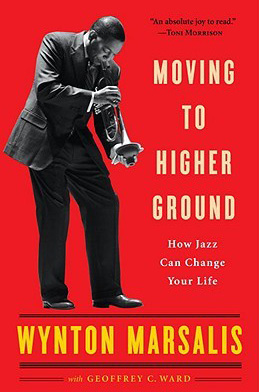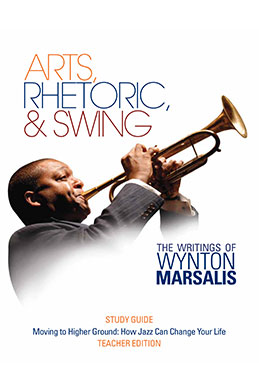Excerpts from the Teacher’s Edition
by Phyllis Magold
Moving to Higher Ground: How Jazz Can Change Your Life is, in essence, a persuasive message. Marsalis clearly states his purpose for writing the book in the Introduction: “I’d like to demystify listening to jazz and show you how the underlying ideas of this music can change your life.”
Marsalis’s literary style actually embodies the essence of jazz. His style manages to be both informal, yet scholarly. His diction bounces back and forth from lofty to colloquial. His tone balances between reverent and didactic and earthy. Sometimes his syntax is clear and crisp and sometimes his ideas seem to be disconnected with little or no transitions. But, like jazz itself, his message comes together and engages the reader in a heartfelt journey to awareness.
The paradoxes of his writing style reflect the ultimate paradoxes that lie within jazz itself. A dominant theme of the book is that jazz expresses the deepest level of humanity’s emotions—all emotions—expressed at the same time. This is most evident, according to Marsalis, in his beloved “blues.”
“With the blues you have layers of meaning. The words say one thing, the way they are sung can say another, and the music always says something else. . . . The blues delivers both joy and sorrow.”
If Marsalis would end his analysis there, with the music, the book would be an excellent vehicle for understanding jazz. But Marsalis’s goal is to present jazz as a life-changing experience, so he extends or applies every lesson about jazz to a lesson about life—and the paradox in the blues becomes the paradox in everyone’s soul.
The book is saturated with soulful stories and anecdotes and definitions, from and about jazz geniuses and maestros. Marsalis has had a professional or personal relationship with many of them, adding depth to the authenticity and ethos of the message. Life’s lessons emerge seamlessly from Louis Armstrong’s rise from the bowels of the economic strata, from John Lewis’s love of European excellence, and from the perseverance of John Coltrane.
It is the “mutual respect” within the jazz band and jazz virtuosos that is the dominant lesson and the one that Marsalis contends should transcend our daily lives ” . . . from individual creativity and personal relationships to the way you conduct business and understand what it means to be a global citizen in the most modern sense.”
Marsalis’s respect for jazz and its players resonates through his words as the book provides an insightful, albeit fragmented, autobiographical narrative of the lessons Marsalis himself has learned through jazz. His personal narrative, sometimes brutally honest, also allows the reader a glimpse of Marsalis’s own development, both as a musician and as a person—all through the filtering lens of jazz and the lessons it teaches.
The life-changing lessons play loud and clear, but there is much background music echoing from the pages of the book. Within the mini-biographies of influential jazz greats and across the pages of jazz history, Marsalis also presents a history of America. What Marsalis describes is a compassionate, historical perspective of not only what is wrong with America, but what is right with America. One cannot detach race from the study of jazz; it is too firmly rooted in the angst of the black experience. However, “Jazz is not race music.” It is its universality and its embodiment of the American concepts of individuality, freedom, and collaboration that make it “America’s greatest artistic contribution to the world.”
In the last chapter of the book, Marsalis extols the virtues of art and creativity. Like a quixotic hero, he looks through reality and sees an absolute essence—an essence that is the core of jazz, the core of America. He sees the higher ground and wants to share it with everyone.


